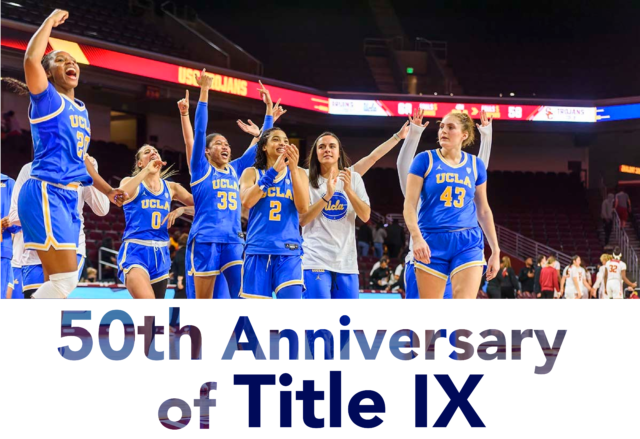This post was updated June 26 at 11:46 p.m.
While sports aren’t male-dominated the way they once were, gender equality still isn’t the norm in the world of sports.
On a day celebrating the 50th anniversary of Title IX, it’s important to recognize the progress made in women’s sports over the past half a century, largely as a product of Title IX. But it’s also important to recognize how far there still is to go in the pursuit of equality in sports.
Fifty years ago to the day, Title IX of the Education Amendments Act of 1972 was enacted into federal law, proclaiming that no person in the United States can be discriminated against on the basis of sex under any education program that receives funding from the federal government. While the law broadly applies to all aspects of education, its impact on high school and collegiate sports has perhaps been its most profound.
Title IX requires that men and women have equal opportunities to participate in college sports, that male and female student-athletes receive scholarship dollars proportional to their participation, and that male and female student-athletes receive equal treatment in terms of other benefits.
In 1972, only 15% of athletes competing on college teams were women. Nearly 50 years later, the rate of female student-athletes grew to 44% by the 2020-2021 season.
There’s no denying the sheer growth not only in participation in women’s sports at the collegiate level but also in the newfound respect and attention paid to women’s sports. But there’s a reason that gender inequality persists in collegiate sports: Title IX is founded on the premise of equity.
As a result, Title IX has failed to prompt equal outcomes in collegiate sports but rather just equal opportunity. Schools routinely skirt the rules and find loopholes to achieve equity – and consequently, Title IX compliance – in their athletics programs with no concern for the ultimate goal of equality.
A recent study done by USA TODAY found that schools use a variety of techniques to manipulate rosters in order to meet Title IX standards. For instance, schools can double or even triple count student-athletes who partake in more than one sport, such as cross country, outdoor track and indoor track. Moreover, the study found some schools pad their women’s rowing rosters to meet requirements.
UCLA is no exception to these findings. The Bruins’ rowing team – for which there is no men’s program – carries 55 rowers on its roster. Similarly, UCLA’s swimming and diving program has 43 student-athletes on its roster with no men’s squad.
There are also still vast disparities in terms of spending between men’s and women’s college sports. In 2021, Oregon women’s basketball forward Sedona Price went viral for exposing the discrepancies between the men’s and women’s sites for the NCAA Tournament. This past season, UCLA women’s basketball was subject to extreme travel schedules on numerous commercial flights during the Women’s National Invitation Tournament, while the men’s teams in the National Invitation Tournament took chartered flights.
[Related: Moon’s Musings: NCAA must take ownership of WNIT as step toward gender equity in basketball]
Coaching salaries across schools also reveal the progress yet to be made in terms of equality. UCLA men’s basketball coach Mick Cronin makes nearly six times what women’s basketball coach Cori Close makes, while baseball coach John Savage brings in over four times the salary of softball coach Kelly Inouye-Perez.
While salaries are often revenue-dependent, there’s no reason that the coach of one of the most historic softball programs in the country should be making considerably less than the coach of a baseball team that hasn’t made the Men’s College World Series in nearly a decade.
[Related: Contracts for coaching: A comparison of coaching salaries at UCLA]
With the college athletics landscape recently undergoing a major shift with last year’s name, image and likeness legislation, schools will have to be wary about the potential for further growth in inequality as largely unregulated endorsement deals take priority in the collegiate scene. While numerous women’s athletes, such as LSU gymnast Olivia Dunne, have profited in a big way from NIL opportunities, that hasn’t necessarily been true for women’s sports as a whole.
Football players alone constitute over 47% of NIL deals, according to Opendorse, while men’s basketball accounts for 15.6% of such deals. Individual female student-athletes have found success in the new NIL landscape, but that hasn’t proven true on a macro level.
There’s no doubt things have changed for the better in the past 50 years. When Title IX was enacted in 1972, UCLA men’s basketball was the best team in the country, fresh off its eighth title in nine years. And yet, the Bruins didn’t even have a women’s basketball program.
On the 50th anniversary of Title IX, we must acknowledge how far women’s sports have come. But we also can’t ignore the shortcomings of what should’ve been a revolutionary step forward in gender equality.
Equity and equality are not one and the same. The next step toward ensuring equality of men’s and women’s sports at the collegiate level will be to transform the athletics landscape at all levels – from coaching to management to media and everything in between.
It will take more than 37 words in federal law to achieve that change.



Comments are closed.